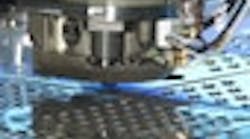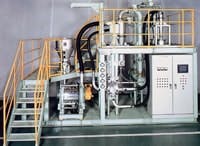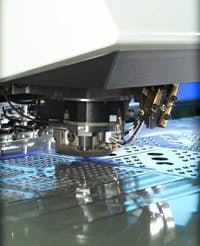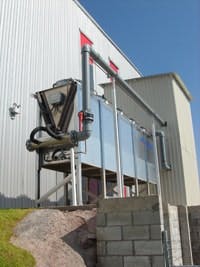From a technology perspective, the high-performance materials used in newer machines are driving the need for higher performance in machine controls. Customers are demanding more intelligence and diagnostic capabilities in controls.
Geographically speaking, the level of machine control intelligence is driven by varying demand for customization in different markets. Generally, North America is highly innovative and entrepreneurial; Europe is R&D-intensive and more likely to use a consortium approach to manufacturing complex products; and Asia remains more volume-oriented and price-driven. The executives indicate that North America, Europe and Asia generally represent a declining order of machine sophistication and customization.Global quality standards and currency valuation are just two more factors in the international business environment that potentially pose challenges for machine builders. The executives argue that, in their experiences, third-party global quality standards usually represent a “lower bar” than local and market-driven quality standards. As for the challenges that various countries’ monetary policies and currency valuations present, some companies have reacted by diversifying their manufacturing capabilities so as to meet the demand for customization and insulate themselves from varying and volatile currency valuations.
In short, machine builders’ strategic approach to serving various international markets must be as customized as their machinery. More than ever, adaptability is critical to success.
High-Performance Materials, Smarter ControlsTo Richard Curless, chief technology officer in the Mag Americas division of Mag Industrial Automation Systems, Sterling Heights, Mich., the biggest change driving the company’s machine controls is more common use of composite materials in equipment for markets that are being greatly impacted by energy costs, such as aerospace and automotive. The company is composed of a group of machine tool and systems companies serving the durable goods industry in North America, Europe and Asia.
“In the past few years there has been a significant change relative to materials,” says Curless. “In aerospace, there has been a leap into composites. It all comes down to the consumption of energy, which is becoming very expensive.” He adds that the new Boeing 787 Dreamliner—which is designed to be 20% more fuel-efficient than comparably sized aircraft—will have a primary structure with up to 50% composite materials. “In the automotive world, it’s been a shift from aluminum to CGI [compacted graphite iron] for engine blocks and heads. You’re starting to see composites in automotive; it’s going to be a whole new world out there.”
The demand for high-strength, lightweight materials also has exploded, says Curless. “When you’ve got a lot of interfaces to deal with and you need structural strength that’s not composite, you need a structural part that you want to use to make up the bulkheads, the landing gears, whatever,” he says. “There’s a tremendous move to titanium and over the past three years, the demand for titanium and titanium machining has just proliferated. There’s not enough equipment in the world today to meet the demands that are coming in the aerospace world for titanium.”
Curless reports that this shift has had a major impact on machines. “New materials are driving the demand for our automated equipment these days,” he says. “We’ve had to develop new tooling, new pieces of equipment that can handle these materials much more readily. Linear motor technology continues to be more capable, so we can have lighter, faster machines with less wear. We started off with linear axes with linear motors. Now we offer a new head design with linear motor technology applied to the A axis and C axis of a head so that there are no gears to drive it. We have new demands for spindle speed, so we’re coming out with higher-speed spindles and more power.”
The changes in machines are, in turn, driving advancements in machine controls, Curless points out. “We just developed a new titanium head and spindle that allows us to have high torque and large tools for stiffness to be able to move titanium,” he says. “We are seeing more-complex axes. There are more five-axis machine tools and a lot more multitasking.”
For example, says Curless, Mag machines use new heads that rotate in the A or C axis; linear motor technology eliminates the need for worms and gears in those head stocks so they can go faster without contact. The result is longer life. Another innovation, adds Curless, is the use of compact motor/drive systems using permanent-magnet motors to generate more torque and power. The use of digital technology in the controls gives the operator better control of dynamics across the entire speed range of machines, he says.
As a result, he says, controls have to get more intelligent than ever. “We’re starting to use laser trackers to calibrate our machinery,” says Curless. Laser trackers capture distance and angles, so the operator can calculate the precise position of machine components throughout its entire range of motion. Curless describes this evolution as a conversion from linear accuracy measurement to volumetric accuracy measurement. Instead of calculating errors on multiple axes, he says, the operator can use the laser tracker to calculate machine component position on any given axis, which drastically reduces calibration time and boosts machine uptime.
Mike Harrington, director of research and development for Alliance Machine Systems International, Spokane, Wash., an equipment provider to the global paperboard packaging industry, says customers want better operator interfaces. “Interestingly, this has become a larger issue in the U.S., and I believe that the U.S. is driving the technology,” he says. “Now, we have U.S. customers who want self-diagnosing machines, copies of wiring diagrams and assembly drawings in pdf on the machine and remote diagnostics.”
To date, says Harrington, it doesn’t appear that Alliance’s European customers are pressing for a high level of diagnostic capability, although he expects this to change soon. “I absolutely do think better diagnostics are a competitive advantage,” he says. “Most of our machines have some sort of human-machine interface and it is very easy to incorporate this into our diagnostics services, which are more than just showing which I/Os are activated.” He adds that once IT departments get used to the idea of giving Alliance remote Internet access to the machines, the concept of remote diagnostics will become a reality and will be a short-term competitive advantage. “It will not last long, as our competition will quickly follow suit, especially overseas competition,” says Harrington.
Adaptability Key in Differing MarketsFor U.S. manufacturers involved in powder processing, international markets currently offer significant growth potential, according to Carl Ishito, director and general manager of AAAmachine, Arlington Heights, Ill. His marketing and consulting company represents manufacturers of equipment for processes such as separating, grinding, compacting and blending that are used in industries from food processing to powder coatings (Figure 1).
According to AAAmachine, which represents manufacturers of powder processing equipment such as the Matsubo Pac, a pulverizing and classification combination system mainly for toner production, the U.S. market is a difficult one in which to sell foreign equipment.
Source: Matsubo Company, Ltd.
In Asian countries other than Japan, U.S. machine builders will find the powder-processing equipment market is price-driven, with moderate-to-low automation requirements, and language, distance and time differences create challenges, claims Ishito. Despite fragmentation and intense competition in China, Taiwan and India, plenty of growth potential exists there, says Ishito. Japan is similar to the rest of Asia, aside from price sensitivity, he says. European customers are less price-sensitive because of higher automation requirements, but language barriers are less challenging, he adds. “The European market is a buying force because of the high euro value,” says Ishito. “So they can buy the same equipment at a lower price than before from the U.S. and Japan.” U.S. machine builders should take a long look at Europe, Japan and developing countries, concludes Ishito.
For powder processing technology as he sees it today, Ishito says the U.S. is high-price, high-quality. Japanese and European companies have good prospects in the U.S. because their domestic markets are similarly high-price, high-quality-focused. He indicates that Chinese companies’ prospects for export to the U.S. are not as bright because their domestic market is more low-price and low-to-moderate quality-focused.
Curless also sums up the cultural and economic differences among the major markets for industrial machines. “I see a lot more entrepreneurship in all the activities that go on in the Americas, which means small startup companies just trying to get things going,” he states. “In Europe, I see sizable organizations that start up and commit to capital and production. I think that in Europe, there’s a trend to move off to other locations for sourcing, but they’re nationalistic. How willing are the Germans to go to Asia to bring stuff back into Germany? I don’t see a lot of that from my end. In Asia, I’d say governments tend to push the manufacturing sector, while industry and academia in Europe try to push its manufacturing sector along and, in the Americas, it’s good old capitalism that pushes manufacturing.”
For U.S. manufacturers, a potential downside definitely exists in offshoring production due to communications and logistics issues, argues Curless. As a result, he says, many Mag customers have begun producing domestically again. But for this practice to result in higher profitability, Curless points out, machines must be ever-faster so that manufacturers can reduce inventory, shipping costs and quality problems.
Harrington says that price is the dominant competitive factor for Alliance Machine Systems’ foreign operations in the global paperboard packaging industry. “Our European operation faces intense competition from OEMs in Europe as well as Southeast Asia,” he says. The primary competitive force is price. In some cases, we can obtain slightly higher prices because of location, service and machine quality. However, the quality aspects are becoming harder to distinguish between competitors.”
Echoing Ishito’s thoughts about foreign imports into North America, Harrington says his company currently has few foreign competitors in the domestic market. But “in the U.S., our customers are in a consolidation phase, which is hampering sales somewhat.” Meanwhile, challenges in exporting products include language barriers and translating documentation to the lowest level of worker education, says Harrington.
Burke Doar, vice president of sales and marketing for Trumpf, the Farmington, Conn.-based North American subsidiary of Trumpf in Stuttgart, Germany, reports that Trumpf is currently seeing growth in countries outside of Germany, including Eastern Europe, China and North America, including Mexico (Figure 2). This growth, believes Doar, results from these countries’ acceptance of free enterprise to improve their populations’ standard of living and is in line with the company’s global diversification strategy. A global network of engineering and manufacturing facilities and local sales and service subsidiaries are in place to get close to the customer and ensure that spare parts can be delivered quickly.
Factors out of Their ControlStrategies exist for machine builders in overcoming barriers to exporting that are out of their control. A couple of major barriers are currency valuation and third-party quality standards.
Trumpf, which manufactures machines for sheet metal processing such as this TruPunch 2020, has noted an increased global demand for user interface optimization and improved diagnostics.
Source: Trumpf
“We want to have the flexibility to adjust our businesses to stay competitive and if we have to move from one site to another to accomplish that, we have the flexibility to do that,” says Curless. “When a customer looks at a Mag product, it wasn’t necessarily built at one site; it means it could be built at multiple sites and built to standards.”
Trumpf’s Doar agrees. “Our diversified manufacturing facilities enable us to react to currency fluctuations,” he says. “The weak U.S. dollar accelerates U.S. exports from large companies that use sheet metal in their products. This increases the demand for more Trumpf machine tools and lasers in North America. The weakness of the dollar does influence sourcing decisions here in the U.S. and provides opportunities for U.S.-based suppliers.”
Harrington says that a strong environment for export to Europe currently exists for Alliance Machine Systems and, although the domestic market has a currency protectionism mechanism of sorts in place, he is mindful that complacency is a dangerous temptation. “Machines made in the U.S. are now cheaper to build and ship to Europe than our machines made in Europe, at least machines that fit inside of containers,” points out Harrington.
“We have been very insulated in the U.S. due to the exchange rate,” says Harrington. “However, global competitors—primarily European—are trying to establish local organizations so that the exchange rate issue disappears. So far, they have not been very successful in this, but we expect and know that they will eventually, or the exchange rate will even out, which will allow them to compete very effectively.” So far, adds Harrington, low-priced Asian competitors have not yet followed European manufacturers’ lead. “We don’t currently see Asian suppliers in our main U.S. marketplace. They are starting to creep into South America but do not have any equipment in the U.S. that we know of. We are very wary of them and are developing strategies to keep our market share.”
No matter where you are, machine automation does the same thing, but different areas put different restrictions on those controls. Tell Machine Builder Nation how geography impacts the machine controls you choose at ControlDesign.com/global.
Adhering to third-party global quality standards is not nearly as critical to success as aiming to meet or exceed quality standards defined by the market. “In the powder technology business, a lot of customers do not care about global quality standards,” says Ishito. “Industry standards are common. An individual or company’s experience is an important factor in choosing the right equipment.”
Harrington says that the quality standards to which Alliance Machine Systems is subject are really safety standards, and regulators in the U.S. and Europe are slow to agree to common standards because they consider their own countries’ manufacturing methods to be superior. “Most of the inspections that are done on machines prior to startup are based upon a regional set of criteria but are then interpreted by the local inspection group,” says Harrington. “In my opinion, this is to protect local markets—whether purposefully or unknowingly.”
Intercontinental Innovation
The Italian Trade Commission provides two examples of Italian manufacturers using innovative controls to help U.S. companies solve manufacturing problems.
Central Can Co., Chicago, recently sought to replace conventional cooling towers to service a new injection molding operation due to concerns about water and energy consumption as well as high maintenance. The company manufactures containers for food, industrial, automotive and consumer markets, and ordered a closed-loop, dry-cooling EcoDry system from Italy-based Frigel and operates the system along with individual chiller/temperature controllers called Microgels (Figure 3).
Figure 3: The use of this closed-loop, dry-cooling EcoDry system from Italy-based Frigel along with individual chiller/temperature controllers is an example of intercontinental partnering some experts feel is an approach that can address the challenges posed by manufacturers of lower-cost equipment.
Source: Frigel Firenze SpA
The system control panel’s PC handles more than 15 digital inputs, more than 15 digital outputs, multiple analog outputs and more than 10 analog input channels. The panel’s microprocessor can interface for field programming and testing or Modbus RTU protocol for remote communication and system diagnostics.
Another example is a recent $3.5 million investment over two years by Polaris Industries, Osceola, Wis., in an automated LaserTube system for cutting and bending metal tube, pipe and solid bar from Italy-based BLM Group. Polaris previously processed its tubing with conventional fabricating equipment that involved three to five machines and manual labor. The new automated system consolidates many tube-fabricating processes into one machine. Via Profibus, a PC-based HMI communicates with a Siemens controller as the machine feeds tubes into a magazine via a sling-type loader, feeds the tubes into a measuring line and processes the tubes using synchronized chucks, a laser head, a cutting head, a weld seam detector and an unloader.
Polaris reports that the system removed 60-80% of direct and indirect labor costs for producing a part compared to conventional techniques, yielded a cost savings of $45 million in expenses over a five-year period and reduced annual hours needed to produce recreational vehicles by 84%.

Leaders relevant to this article:








